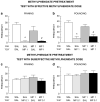Methylphenidate disrupts social play behavior in adolescent rats
- PMID: 18305462
- PMCID: PMC2580804
- DOI: 10.1038/npp.2008.10
Methylphenidate disrupts social play behavior in adolescent rats
Erratum in
- Neuropsychopharmacology. 2008 Nov;33(12):3021
Abstract
Methylphenidate is the first-choice treatment for attention-deficit/hyperactivity disorder (ADHD), but its mechanism of action is incompletely understood. The cognitive effects of methylphenidate have been extensively studied, but little is known about its effects on spontaneous social behavior. During adolescence, rats display a characteristic, highly vigorous form of social behavior, termed social play behavior, which is of critical importance for social and cognitive development. We investigated the neurobehavioral mechanisms by which methylphenidate affects social play behavior in rats. Methylphenidate (0.3-3.0 mg/kg, s.c. or p.o.) abolished social play behavior, without altering general social interest. This effect of methylphenidate did not depend upon the baseline level of social play and was not secondary to changes in locomotion. Furthermore, the play-suppressant effect of methylphenidate was not subject to tolerance or sensitization. Methylphenidate blocked both the initiation to play and the responsivity to play initiation. The effect of methylphenidate was mimicked by the noradrenaline reuptake inhibitor atomoxetine, which is also used for the treatment of ADHD, and was blocked by an alpha-2 adrenoceptor antagonist. In addition, combined administration of subeffective doses of methylphenidate and atomoxetine suppressed social play. However, blockade of alpha-1 adrenoceptors, beta-adrenoceptors, or dopamine receptors did not alter the effect of methylphenidate. These data show that methylphenidate selectively blocks the most vigorous part of the behavioral repertoire of adolescent rats through a noradrenergic mechanism. We suggest that the effect of methylphenidate on social play is a reflection of its therapeutic effect in ADHD, that is, improved behavioral inhibition. However, given the importance of social play for development, these findings may also indicate an adverse side effect of methylphenidate.
Figures





References
-
- American Psychiatric Association . Diagnostic and Statistical Manual of Mental Disorders. IV-TR edn. American Psychiatric Association; Washington, DC: 2000.
-
- Andersen SL, Arvanitogiannis A, Pliakas AM, LeBlanc C, Carlezon WA., Jr Altered responsiveness to cocaine in rats exposed to methylphenidate during development. Nat Neurosci. 2002;5:13–14. - PubMed
-
- Arakawa O. Effects of methamphetamine and methylphenidate on single and paired rat open-field behaviors. Physiol Behav. 1994;55:441–446. - PubMed
-
- Arnsten AFT. Stimulants: therapeutic actions in ADHD. Neuropsychopharmacology. 2006;31:2376–2383. - PubMed
Publication types
MeSH terms
Substances
Grants and funding
LinkOut - more resources
Full Text Sources

